Survival team building exercises are interactive activities designed to enhance teamwork, problem-solving, and communication through realistic survival scenarios, fostering collaboration and real-world survival skills development.
What is a Survival Team Building Exercise?
A survival team building exercise is an interactive activity where participants work in groups to solve hypothetical survival scenarios, fostering collaboration and critical thinking. These exercises often involve ranking essential items, making consensus decisions, and adapting to challenging environments. They are designed to simulate real-world survival situations, encouraging teams to communicate effectively, think creatively, and rely on each other’s strengths. By focusing on problem-solving and teamwork, these exercises help build trust, enhance leadership skills, and improve overall group dynamics. They are widely used in corporate and educational settings to promote bonding and prepare individuals for high-pressure situations. Survival exercises are engaging, educational, and impactful.
Importance of Team Building in Survival Scenarios
Team building is crucial in survival scenarios as it fosters reliance on others, enhances trust, and strengthens communication. When faced with life-threatening situations, individuals must depend on their team’s collective skills and decision-making. Collaboration ensures efficient resource management, reduces panic, and increases problem-solving capacity. Strong team dynamics improve morale, resilience, and adaptability, which are vital for overcoming challenges. In survival, unity and coordination often determine success, making team building an essential component of preparation. It prepares individuals to work cohesively, prioritize tasks, and support each other under stress. Ultimately, effective team building enhances the likelihood of survival by creating a united, resourceful, and resilient group.
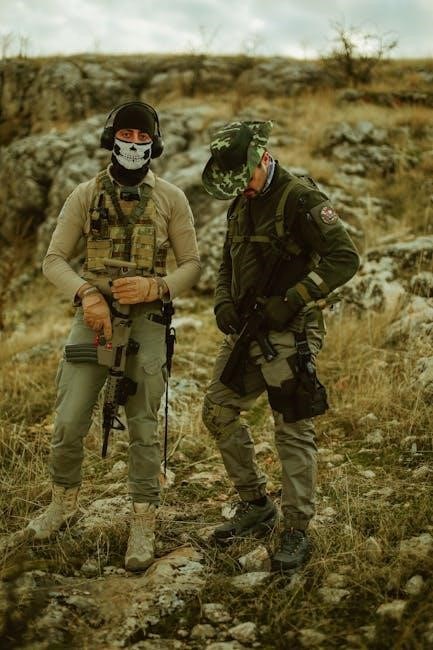
Benefits of Survival Team Building Exercises
Survival team building exercises enhance overall teamwork, boost morale, and prepare teams for unexpected challenges through practical experience, and foster accountability and resilience.
Enhancing Communication Skills
Survival team building exercises excel at fostering clear and effective communication among participants. In high-stress scenarios, teams must exchange ideas, listen actively, and convey instructions precisely to achieve common goals. These exercises push individuals to articulate their thoughts clearly and ensure messages are understood, which is critical in life-or-death situations. By encouraging open dialogue and collaboration, survival exercises strengthen verbal and non-verbal communication, enabling teams to make quick, informed decisions. This enhanced communication not only boosts teamwork but also builds stronger interpersonal connections, fostering mutual respect and trust. Improved communication skills gained through these exercises are invaluable for both survival contexts and everyday collaboration.
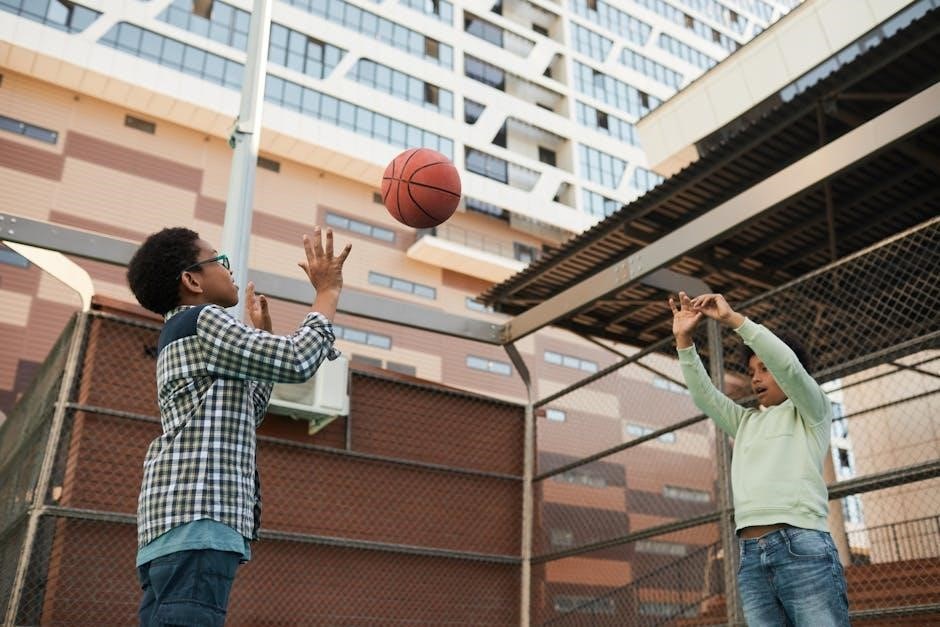
Improving Problem-Solving Abilities
Survival team building exercises are highly effective at enhancing problem-solving skills, as they often present complex, unpredictable challenges. Participants must think critically and creatively to overcome obstacles, such as navigating treacherous terrain or managing limited resources. These scenarios encourage teams to brainstorm solutions, evaluate options, and adapt quickly to changing circumstances. The pressure of survival simulations accelerates learning, fostering resourcefulness and logical decision-making. By practicing problem-solving in a collaborative environment, individuals develop the ability to approach challenges methodically and confidently. These skills are not only essential for survival situations but also transferable to real-world professional and personal challenges, promoting overall cognitive agility and resilience.

Promoting Collaboration and Trust
Survival team building exercises excel at fostering collaboration and trust among participants. These activities often require individuals to rely on each other’s strengths, share responsibilities, and work toward a common goal. By facing survival challenges together, team members build trust through mutual support and accountability. Collaborative tasks, such as building shelters or navigating difficult terrain, encourage open communication and teamwork. Trust is strengthened as individuals witness each other’s dedication and problem-solving skills firsthand. These shared experiences create strong bonds, enabling teams to function cohesively in high-pressure situations. The reliance on one another during survival scenarios translates to greater trust and collaboration in real-world applications, enhancing overall team dynamics.

Designing a Survival Team Building Exercise
Designing a survival team building exercise requires careful planning and creativity to ensure engagement and effectiveness. It involves balancing realism, safety, and fun while tailoring activities to the group’s needs.
Setting Clear Objectives
Setting clear objectives is crucial for designing an effective survival team building exercise. Objectives should be specific, measurable, and aligned with the team’s goals. They should focus on fostering collaboration, enhancing problem-solving skills, and preparing participants for real-life survival situations. Objectives may include improving communication, building trust, and increasing adaptability under pressure. Ensure the objectives are realistic and achievable within the exercise’s timeframe. Clearly communicate these goals to participants to maintain focus and direction. Well-defined objectives also help in assessing the exercise’s success and identifying areas for improvement. This step ensures the activity remains purposeful and impactful for all involved.
Creating Realistic Survival Scenarios
Creating realistic survival scenarios is essential for an engaging and effective team building exercise. Scenarios should mimic real-life challenges, such as natural disasters, wilderness navigation, or resource scarcity, to simulate authentic survival conditions. Incorporate elements like unpredictable weather, limited supplies, and terrain obstacles to heighten realism. Tailor scenarios to the team’s skill level and environment to ensure relevance. Introduce unexpected challenges, such as injuries or equipment failures, to test adaptability. Use props and immersive storytelling to enhance the experience. Realistic scenarios foster active participation, critical thinking, and teamwork, preparing participants for actual survival situations while promoting bonding and problem-solving skills in a dynamic setting.
Ensuring Participant Engagement
Ensuring participant engagement is vital for the success of survival team building exercises. Start by clearly communicating the objectives and expectations to create a shared understanding. Encourage active participation by assigning roles and responsibilities, ensuring everyone feels involved. Foster a supportive environment where feedback is constructive and positive. Incorporate interactive elements, such as challenges or competitions, to maintain interest and motivation. Provide opportunities for reflection and discussion, allowing participants to share experiences and insights. Recognize and reward teamwork and achievements to boost morale. Make the exercise enjoyable and relevant, ensuring it aligns with the team’s goals and strengths. Engagement drives learning and collaboration in survival scenarios, making it essential for a meaningful experience.
Survival Scenario Ideas
Survival scenarios offer diverse challenges, from desert to marine environments, fostering adaptability, teamwork, and critical thinking under pressure. Each scenario simulates real-life survival situations, enhancing preparedness and collaboration.
Desert Survival
Desert survival scenarios simulate extreme conditions, focusing on heat management, water conservation, and navigation. Teams must work together to locate resources, build shelter, and signal for help. These exercises emphasize resourcefulness and adaptability, as participants face challenges like dehydration and limited visibility. Practical skills, such as identifying edible plants and creating solar stills, are often incorporated. The harsh environment fosters collaboration, as team members rely on each other’s strengths to overcome obstacles. This scenario is ideal for developing problem-solving and leadership skills, ensuring participants can thrive in high-stress, resource-scarce situations. Realistic props and challenges enhance immersion, making learning memorable and impactful for teams.
Jungle Survival
Jungle survival scenarios are designed to test teams in dense, unpredictable environments. Participants must navigate through thick vegetation, manage limited resources, and contend with wildlife threats; These exercises focus on teamwork, as members rely on each other to build shelters, start fires, and locate safe water sources. Problem-solving is critical, as teams face challenges like crossing rivers or identifying edible plants. Collaboration and adaptability are key, as the jungle’s harsh conditions demand quick thinking and resourcefulness. These scenarios also promote trust, as team members must work together to overcome obstacles and ensure everyone’s safety. The immersive nature of jungle survival fosters strong bonding and enhances overall team cohesion, making it an effective team-building tool.
Marine Survival
Marine survival exercises simulate scenarios where teams must survive at sea or in coastal environments. Challenges include managing limited water, signaling for help, and navigating unpredictable tides. Teams must work together to ration supplies, repair equipment, and stay afloat. Communication is vital, as clear instructions and roles ensure safety. Problem-solving skills are tested through tasks like constructing rafts or identifying safe landing points. Trust and collaboration are strengthened as members rely on each other to endure the harsh marine conditions. These exercises also teach adaptability, as teams must respond to changing weather and unexpected obstacles. Marine survival fosters resilience and unity, making it an invaluable team-building experience.
Structuring the Exercise
Structuring a survival team building exercise involves organizing the event into clear phases to ensure effectiveness. Start with pre-exercise preparation, setting clear objectives and creating realistic scenarios. During the exercise, define roles and responsibilities to engage participants actively. Afterward, conduct a thorough debriefing session to review performance and gather feedback. This structured approach ensures the exercise is goal-oriented, immersive, and leads to meaningful team development.
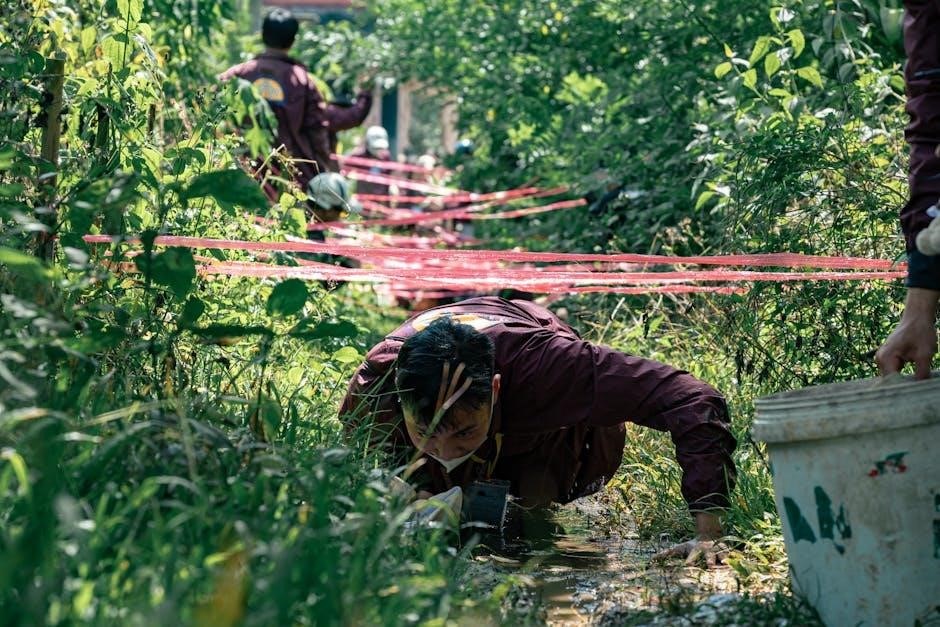
Pre-Exercise Preparation
Pre-exercise preparation is crucial for a successful survival team building exercise. Start by defining clear objectives and outcomes, ensuring they align with the team’s needs. Select a suitable location that mimics real survival conditions, such as deserts or jungles, and ensure safety measures are in place. Conduct a thorough equipment check, including essentials like water, first aid kits, and communication devices. Brief participants on the scenario, rules, and expected outcomes to set expectations. Assign roles to promote accountability and collaboration. Finally, review safety protocols to minimize risks and ensure everyone is mentally prepared for the challenge ahead.

During the Exercise: Roles and Responsibilities
During the survival team building exercise, assigning clear roles and responsibilities ensures effective collaboration. Designate a leader to guide decision-making and coordinate tasks. Each team member should have specific duties, such as navigator, resource manager, or communicator. This promotes accountability and ensures all aspects of survival are addressed. Encourage participants to stay focused on their roles while contributing to the group’s overall success. Rotate roles midway to foster adaptability and leadership development. Emphasize the importance of active participation and mutual support. Clear responsibilities help simulate real-life survival scenarios, making the exercise more immersive and impactful for team growth.
Post-Exercise Debriefing
Post-exercise debriefing is a critical phase where participants reflect on their experiences. Facilitators guide discussions to uncover challenges, successes, and lessons learned. Open dialogue encourages teams to analyze their strategies and identify strengths and weaknesses. This session fosters accountability, reinforces learning, and enhances future performance. Participants share insights, and feedback is collected to refine approaches. Debriefing strengthens team cohesion and prepares members for real-life survival situations by solidifying new skills and mindsets. It’s an essential step to ensure growth and readiness for future challenges.
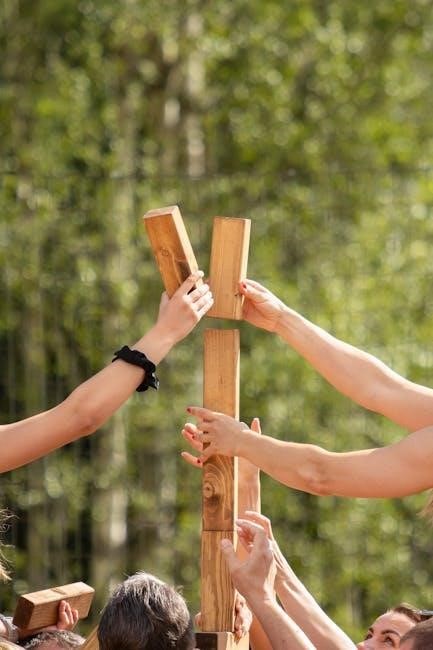
Tools and Resources
Downloadable survival guides, essential item checklists, and practical tools like first aid kits and navigation aids are crucial for effective team building exercises.
Essential Survival Items List
An essential survival items list is a cornerstone of any team building exercise, ensuring participants are prepared for emergency scenarios. This list typically includes water, non-perishable food, first aid kits, shelter materials, fire starters, multi-tools, navigation tools like maps and compasses, communication devices, light sources such as flashlights, and personal protection items. These items are selected based on their versatility and ability to address basic human needs in survival situations. The list serves as a guide for teams to prioritize resources, fostering collaboration and strategic thinking. By mastering this list, participants gain practical skills and confidence in real-world survival challenges.
Downloadable PDF Guides
Downloadable PDF guides are invaluable resources for organizing and executing survival team building exercises. These guides often include comprehensive checklists of essential items, step-by-step instructions for various survival activities, and diagrams for constructing shelters. They may also incorporate tips on leadership and communication strategies to enhance teamwork. Many PDF guides are designed to be easily accessible and printable, making them convenient for facilitators to distribute to participants. By providing structured content, these guides help ensure that exercises are both educational and engaging, preparing teams for real-world survival scenarios. They are a key tool in fostering preparedness and collaboration among participants and practical application.
Facilitating the Exercise
Facilitating a survival team building exercise requires a structured approach to ensure effectiveness. The facilitator must create a realistic environment that mimics survival conditions while maintaining safety. Assigning roles such as leader, navigator, and resource manager encourages accountability. The facilitator should observe team dynamics, offering guidance without interfering excessively. Providing timely prompts and challenges helps keep the exercise engaging. Active participation is key, as it fosters collaboration and problem-solving. The facilitator must also ensure that all participants understand the objectives and rules beforehand. By balancing supervision and autonomy, the facilitator enables teams to learn and grow through shared experiences, enhancing their survival and teamwork skills effectively.
Evaluating the Exercise
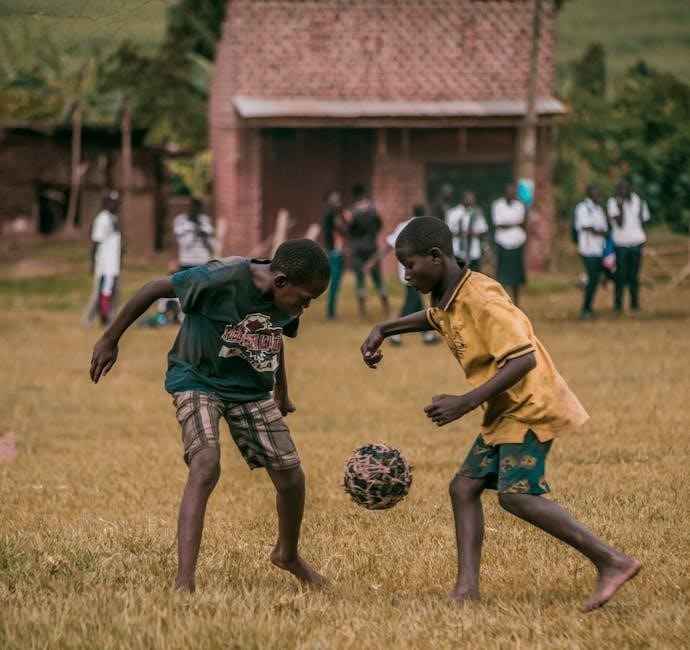
Evaluating survival team building exercises involves assessing performance, feedback, and areas for improvement. Observation and debriefing help measure success and identify growth opportunities for future sessions.
Measuring Team Performance
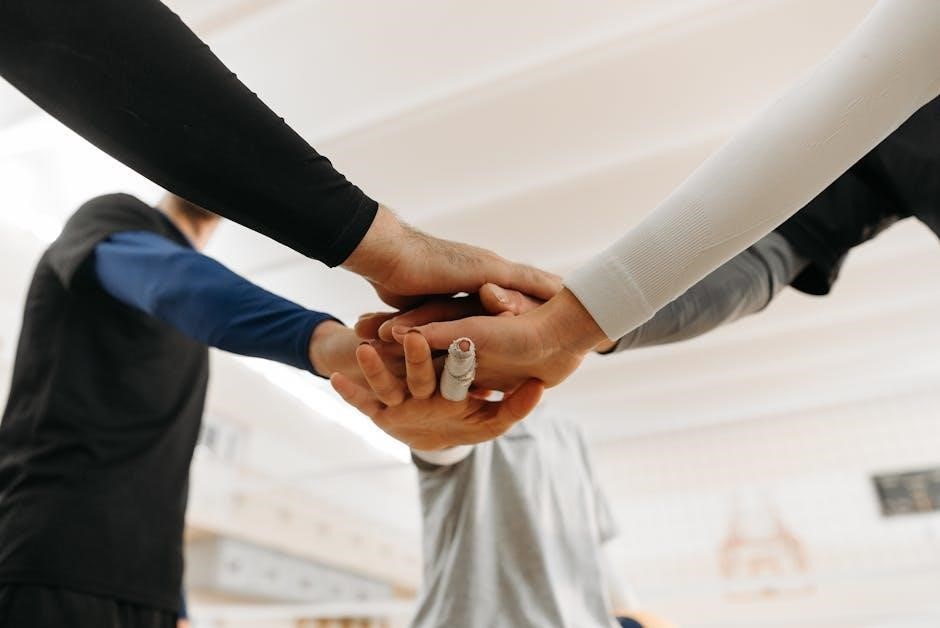
Measuring team performance in survival exercises involves assessing how effectively groups achieve objectives, communicate, and problem-solve. Key metrics include time to complete tasks, resource utilization, and decision-making accuracy. Observers score teams based on teamwork, adaptability, and adherence to survival principles. Success is also measured by the team’s ability to stay safe, conserve energy, and maintain morale. Post-exercise evaluations highlight strengths and weaknesses, providing insights for improvement. Metrics are often aligned with the exercise’s goals, ensuring a clear understanding of what was achieved and what needs refinement. This structured approach helps identify areas for growth and reinforces teamwork in high-stress scenarios.
Gathering Feedback
Gathering feedback is crucial for understanding the effectiveness of survival team-building exercises. Participants and facilitators provide insights through surveys, group discussions, or one-on-one interviews. Feedback highlights strengths, such as improved communication, and areas needing improvement, like decision-making under pressure. Open discussions encourage honest reflections, helping teams identify what worked and what didn’t. Feedback also reveals participant engagement levels and perceived challenges. This data is invaluable for refining future exercises and ensuring they meet their objectives. By capturing diverse perspectives, feedback fosters continuous improvement and enhances the overall impact of the survival team-building experience. It ensures the exercise evolves to better serve the team’s needs.
Identifying Areas for Improvement
Identifying areas for improvement is essential for refining survival team-building exercises. By analyzing feedback and observing team dynamics, facilitators can pinpoint weaknesses, such as communication gaps or inefficient problem-solving. These insights help create targeted strategies for growth. For example, if a team struggled with resource allocation, future exercises can emphasize budgeting and prioritization. Actionable steps, like additional training or revised scenarios, address these issues. Regular assessment ensures continuous improvement, making teams more resilient and effective in survival situations. This iterative process fosters adaptability and readiness, ultimately enhancing overall performance in high-stress environments. Improvement is a cornerstone of successful team development.
Survival team building exercises effectively enhance teamwork, problem-solving, and adaptability, preparing individuals for real-life survival scenarios while fostering resilience and strong team dynamics.
Final Thoughts on Survival Team Building
Survival team building exercises are powerful tools for fostering resilience, collaboration, and adaptability. They simulate real-world challenges, encouraging teams to think critically and rely on each other’s strengths. By immersing participants in realistic scenarios, these exercises reveal the importance of communication, trust, and leadership. They also highlight the value of preparation and resourcefulness. Over time, such activities not only enhance team cohesion but also equip individuals with practical survival skills. The lessons learned extend beyond the exercise, promoting continuous growth and readiness for unexpected situations. Incorporating these exercises into team development programs can yield long-term benefits for both personal and professional environments.
Encouraging Ongoing Team Development
Encouraging ongoing team development is essential for sustaining the benefits of survival team building exercises. Regular follow-up activities, such as workshops or smaller group challenges, help reinforce skills and foster continuous improvement. Providing feedback and encouraging reflection on past exercises ensures teams learn from their experiences. Leaders should promote a culture of collaboration and open communication, allowing team members to share insights and strategies. Additionally, offering resources like survival guides or training sessions can deepen their knowledge. Recognizing progress and celebrating successes motivates teams to stay engaged. By integrating these practices into their routine, organizations can create a resilient, adaptable, and high-performing team ready for any challenge.